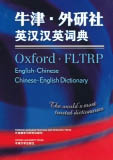TIMELY AND TOPICAL
TIMELY AND TOPICAL
By staff reporter SUE DUNCAN
|
 |
Oxford - FLTRP English-Chinese, Chinese-English Dictionary Published by Foreign Language Teaching and Research Press and Oxford University Press Pages: 2,064 Price: RMB 199 (China) (Published in UK as Oxford Chinese Dictionary at £45) |
IT is predicted that in a few years, the English-learning population in China will exceed the combined total population of all native-English-speaking countries. And there are the stirrings of reciprocal interest: one in seven schools in England now offers Mandarin, and there is a rush by schools across America to offer instruction in Chinese. It all adds up to a healthy market for the new Oxford-FLTRP English-Chinese, Chinese-English Dictionary.
The dictionary, published last September, makes a very timely addition to the libraries of such students: the long-term occupants of shelf space were perhaps beginning to show signs of their age, struggling to reflect changes in society, business, science and technology. Added to this, the Internet age is spawning expressions unknown just a decade back.
The publishers' stated aim of the ground-breaking collaboration between Oxford University Press and Beijing's Foreign Language Teaching and Research Press is to provide translators, students at all levels, teachers and businesspeople with a reference work unrivalled in authority, accuracy and currency.
Dr. Samuel Johnson, the 18th century English critic and compiler of A Dictionary of the English Language famously defined a lexicographer as "a writer of dictionaries, a harmless drudge." The drudgery may have been eliminated by the Web-based electronic dictionary-compilation system used, but even so the work took six years to complete and the involvement of 60 editors and native-speaker translators.
It all adds up to the largest single-volume English-Chinese-English dictionary ever put together. The 2,064-page product contains 300,000 words and 370,000 translations. Weighing in at nearly 3 kg, it's a safe bet that this hefty tome will remain on the study desk as a reference tool.
One is immediately impressed by the large print and clarity of the layout: In the Chinese-English section the head hanzi and pinyin headings are large and clear, making for easy navigation. For each entry the pronunciation is given in pinyin, followed by a translation/explanation and often an example in a grammatical construction.
The English-Chinese section has, however, drawn adverse comment for providing definitions only in Chinese characters, withholding (because of space constraints) any pinyin guide to pronunciation. This is a bizarre and irritating omission, compounded when one looks up a character in the radical index and is referred to a page in the C-E section, only to discover that the page numbers are located at the gutter rather than at the page edge, making leafing through more difficult than it need be. Hopefully, such issues can be addressed in future printing. Electronic versions that will include pinyin are apparently in the works, but no publication date has been given.
But there are plenty of compensating features. As well as clear tagging of British and American English variants, users will appreciate the register labels indicating a spectrum of nuanced usage – for example taboo slang, euphemism, formal, offensive.
Cultural notes, boxed near to where the word occurs, give additional information to supplement the bare translation. For example: Baby boom, Poet Laureate and political correctness in the E-C section and Lord Guan, jiu wines and spirits, People's Daily in the C-E section.
Useful phrases for using telephone, email, Internet, or SMS are grouped in the center section, together with model letters for more formal communications, plus Chinese, British and American historical chronologies.
The launch publicity points to the topical nature of the entries, singling out such phrases as fenqing (angry youth), shanzhai (knock-off copy) and boyun (cloud seeding). Another Netizen term that makes it is leiren (astonishing), but geili (awesome) does not, possibly because of the compilers' guidelines that candidate entries had to be in wide use across different media in China, over a number of years.
Resistant to change in a fast-moving linguistic world are chengyu – four-character capsule phrases often rooted in traditional Chinese stories. Their allusions have instant meaning for native speakers, but can sound senseless in English and are the bane of many a translator. For example, saiweng shima (塞翁失马), literally means "the old frontiersman who lost his horse" but is the English equivalent of "a blessing in disguise." Similarly "qiren youtian (杞人忧天) can be translated as "the man of Qi who feared the sky," or as "someone entertaining imaginary fears." Taking a small random selection of chengyu and comparing this dictionary with a Chinese-English- only dictionary showed they were represented in both, but with fewer alternative translations in the two-way version, obviously for space reasons.
The 21st century has presented us with new concerns and Oxford-FLTRP are on the case. Toxic debt, sub-prime mortgage market, ecocatastrophe, eco-labelling, carbon footprint, bioterrorist and suicide bomber are indicative of the times we live in and the financial, environmental and security issues that worry us. Sadly, this new vocabulary promises to be rather less ephemeral than Netizen-speak.
Services
Economy
- Eco-agriculture and Eco-tourism Power Nanchang’s Green Development
- Balance Environmental Protection and Economic Prosperity – Nanchang Looks to European Technology for Green Development
- Sustainable Growth Requires Wiser Energy Use
- Chinese Economy: On the Path of Scientific Development
- China's Economy over the Last Ten Years

